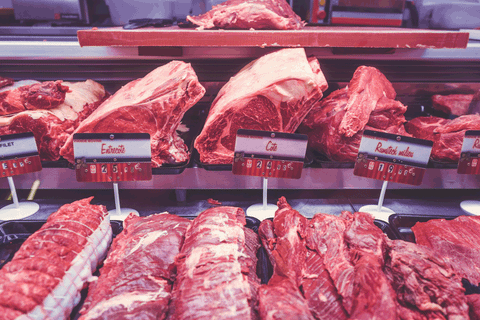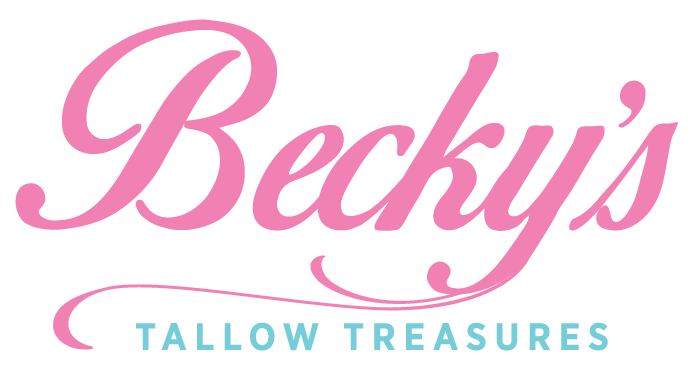
Rubbing animal fat on one's body is not in the slightest appealing, yet that is the image conjured up when I explain that my soap is made from grass fed tallow -- beef fat. The idea of "washing" with fat leaves questions like, "Won't it leave me feeling greasy?" "Won't it smell rancid?" and "Is soap really made from fat!?" I assure you, it is. And the best soap is made with animal fat. There are veggie soaps and pure olive oil soaps, but they either rapidly disintegrate in the shower or they feel slimy like snot (how's that for appealing?). We know soap isn't just a glob of fat sitting in our shower dish so lets continue.
Soap results from a chemical reaction between a fat and an alkali. Our word for soap derives from the Latin word, "sapo." Hence the process of "turning into soap" is called "saponification." Alkalies range from the more common potassium hydroxide and sodium hydroxide, to the lesser known aluminum hydroxide and sodium bicarbonate. That's right, people! Even baking soda can make a soap; although, it takes a painfully long time to finally saponify. However, each alkali has it's place. Sodium hydroxide (NaOH) is used for making solid soap, while potassium hydroxide (KOH) is used for making liquid soap. Sometimes we combine the two to manipulate the type of lather we achieve. However, soap is not the only by product of this chemical equation! In the end, we also get glycerin. This beautiful, skin-loving humectant draws moisture to your skin helping it stay plump and moisturized. Unfortunately, some manufacturers will extract this and sell it on the side for more profit. 
To clarify, I'm not using raw fat that still has all the blood, bones, and ligaments attached. The beef fat goes through a rendering process to take that raw, slab of fat and turn it into an oil. The oil, now called tallow, is cleaned of it's cracklings which are the deep fried ligaments. It's the same process which takes that fat on a strip of bacon and turns it into "bacon grease" (A.K.A. lard). Fun fact, back in grandma's day, they didn't even bother removing the cracklings before they added the lye to the mix. In fact, they would let the lye dissolve the cracklings so the end result was some ugly, brown soap.
Even though we use a caustic chemical such as lye, when calculated correctly, there is neither fat nor lye left in the final equation. However, this doesn't stop us from reminiscing about grandma's harsh soap. Back in her day, it was more of a guess. There weren't precise scales that weighed to the nearest hundredth gram. It was all done by taste testing to see if the soap still "zapped." This zap, by the way, is the bite of active lye on your tongue.
Fatty acids comprise the main structure of each fat or oil. Examples of fatty acids are lauric, myristic, stearic, and palmitic acid just to name a few. When transformed by lye, each of these fatty acids gives a different property to the soap. When some oils are saponified, they make a very stripping and drying soap. Other oils, like olive oil, seem gentle to the skin but have absolutely no lather at all.

With much room for interpretation, as a soap maker, it's both science and art to develop a truly luxurious soap. It's why not all handmade soaps are equal, yet most are more gentle than commercial detergents. With careful calculations and methodical choice of ingredients, we can craft a beautiful product that lathers well and leaves the skin soft and moisturized.
Thanks for reading!




RECOVER YOUR LOST CRYPTO ASSETS WITH ASORE HACK INTELLIGENCE. NO UPFRONT PAYMENT REQUIRED.
Asore Corp. is a team of Cyber Intelligence, Crypto Investigation, Asset Tracing and ethical hacking experts. Working together to form a private cyber and crypto intelligence group focused on providing results.
Using the latest Cyber Tools, Open Source Intelligence (OSINT), Human Intelligence (HUMINT), and cutting edge technology, we provide actionable intelligence to our clients.
WHY CHOOSE US?
– Expert Cyber Investigation Services —Our cyber investigators operate professionally and anonymously to crack all firewalls known to man.
– Cryptocurrency And Digital Asset Tracking — We are able to track the movement of different crypto currencies and assets. If the asset has been moved, we are able to follow it.
– Strategic Intelligence For Asset Recovery — The first step to recovery is locating recoverable assets. Our experienced team will be able to walk you through the process.
Schedule a mail session with our team of professionals today via – asorehackcorp (@) gmail (.) com to get started immediately.
BEWARE of FABRICATED reviews and testimonies endorsing tricksters, do not get scammed twice.
Disclaimer: Asore Corp. is not a law enforcement agency and not a law firm. Like all private investigators, we cannot guarantee specific results, but we apply our expertise and resources to every case professionally and ethically.5